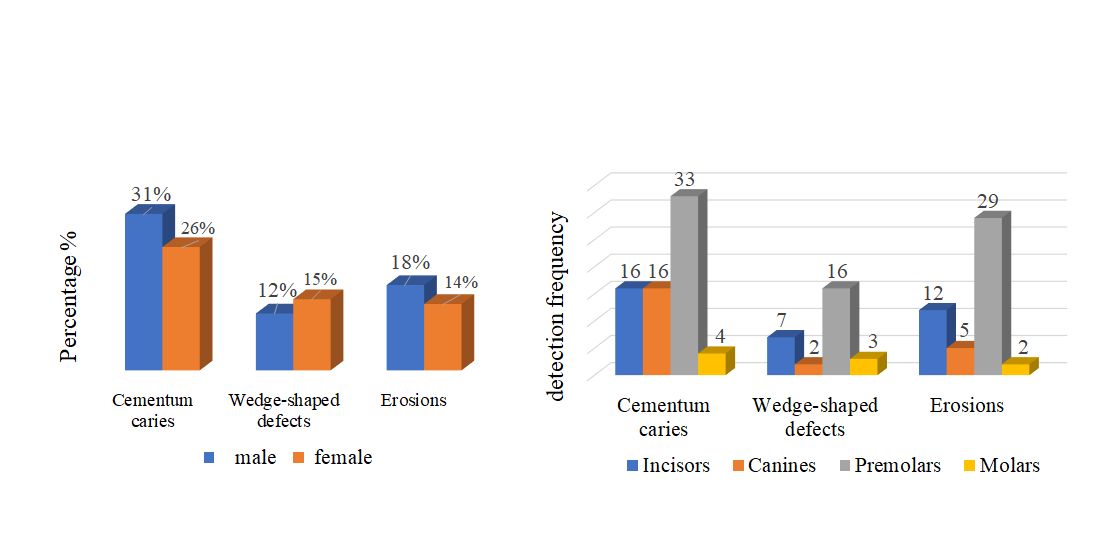Analysis of the frequency of cervical pathology manifestation in permanent teeth of different groups
DOI:
https://doi.org/10.15587/2519-4798.2024.300702Keywords:
cervical tooth lesions, cervical caries, wedge-shaped defects, erosions, middle ageAbstract
Cervical tooth lesions today belong to the most common dental pathologies characterized by a pronounced tendency to increase.
The aim of our study was to determine the frequency of various types of cervical pathology in formed permanent teeth.
Material and methods. The randomized group of examined patients included 200 middle-aged individuals (100 males and 100 females). The examination included collecting anamnestic data and examining the oral cavity and teeth to identify cervical caries and non-carious lesions of cervical localization.
Results. Various types of cervical tooth pathology were found in 45 % of the total number of examined patients. The highest percentage among cervical lesions belongs to cervical caries (28.5 %). The frequency of cervical erosions is 16 %, and wedge-shaped defects - 13.5 %. Cervical caries and erosions are more often detected in males, while wedge-shaped defects are more common in females. In females, isolated cervical caries are most frequently manifested (36 %), and isolated wedge-shaped defects and erosions are less frequent (16 % and 17 % respectively). The least frequent manifestation in females is the combined lesion of teeth with wedge-shaped defects and erosions (5 %). In males, isolated cervical caries is most frequently detected (42 %), isolated erosions are nearly twice less common (23 %), and isolated wedge-shaped defects (8 %) and combined lesions of teeth with wedge-shaped defects and erosions (4 %) are the least frequent. All types of cervical pathology most often affect premolars, less often incisors, and least often molars.
Conclusions. 45 % of middle-aged individuals seeking dental care have cervical tooth lesions, with the highest percentage being cervical caries. Cervical caries and erosions are more common in males, while wedge-shaped defects are more common in females. All types of cervical pathology most often affect premolars and, least often, molars
References
- Zabolotna, I. I., Hontsytska, O. S. (2009). Suchasni uiavlennia pro etiopatohenez nekarioznoi patolohii zubiv, shcho vynykaie pislia yikh prorizuvannia. Aktualni problemy suchasnoi medytsyny: Visnyk ukrainskoi medychnoi stomatolohichnoi akademii, 9 (4), 238–243.
- Zabolotna, I. I. (2020). Individual prediction of development of cervical dental tissue pathology based on the parameters of oral fluid. Reports of Vinnytsia National Medical University, 24 (4), 624–628. https://doi.org/10.31393/reports-vnmedical-2020-24(4)-11
- Udod, O. A., Fedishyn, M. M. (2023). Tooth periodontal lesions and patient hygiene habits. Proceedings of the XXI International scientific and practical conference Informational, modern and recent theories of development. Madrid, 197.
- Zaverukha, Y. A. (2021). Distribution of occlusal load in teeth with wedge-shaped defects of different depths. Oral and General Health, 2 (3), 79.
- Braylko, N. M., Tkachenko, I. M. (2020). Study of the stress-strain state of the "filling-tooth" system in cervical defects of teeth. Current problems of modern medicine: Bulletin of the Ukrainian Medical Stomatological Academy, 20 (4 (72)), 108–114. https://doi.org/10.31718/2077-1096.20.4.108
- Zabolotna, I. (2021). Study of the morphological structure of enamel and correlation of its chemical composition with dentin in intact teeth and with a cervical pathology. Journal of Stomatology, 74 (1), 9–15. https://doi.org/10.5114/jos.2021.104691
- Herman, S. I., Sokolova, I. I., Savielieva, N. M. (2022). Vidnovlennia klynopodibnykh defektiv nanonapovnenym materialom za metodykoiu rozdilenykh inkrementiv. Teoriia ta praktyka suchasnoi stomatolohii. Kharkiv, 46–49.
- Zabolotna, I. I. (2021). Method for predicting the development of cervical caries and teeth with wedge-shaped defect in young people. Reports of Vinnytsia National Medical University, 25 (1), 102–106. https://doi.org/10.31393/reports-vnmedical-2021-25(1)-19
- Pikdöken, L., Akca, E., Gürbüzer, B., Aydil, B., Taşdelen, B. (2010). Cervical wear and occlusal wear from a periodontal perspective. Journal of Oral Rehabilitation, 38 (2), 95–100. https://doi.org/10.1111/j.1365-2842.2010.02137.x
- Mazur, I. P., Suprunovych, I. M. (2018). Loss of dental hard tissue (non-carious lesions): clinic, differential diagnosis (review). Modern dentistry, 5, 6–12.
- Nascimento, M., Dilbone, D., Pereira, P., Geraldeli, S., Delgado, A., Duarte, W. (2016). Abfraction lesions: etiology, diagnosis, and treatment options. Clinical, Cosmetic and Investigational Dentistry, 3 (8), 79–87. https://doi.org/10.2147/ccide.s63465

Downloads
Published
How to Cite
Issue
Section
License
Copyright (c) 2024 Zoriana Masna, Danylo Yakymovych

This work is licensed under a Creative Commons Attribution 4.0 International License.
Our journal abides by the Creative Commons CC BY copyright rights and permissions for open access journals.
Authors, who are published in this journal, agree to the following conditions:
1. The authors reserve the right to authorship of the work and pass the first publication right of this work to the journal under the terms of a Creative Commons CC BY, which allows others to freely distribute the published research with the obligatory reference to the authors of the original work and the first publication of the work in this journal.
2. The authors have the right to conclude separate supplement agreements that relate to non-exclusive work distribution in the form in which it has been published by the journal (for example, to upload the work to the online storage of the journal or publish it as part of a monograph), provided that the reference to the first publication of the work in this journal is included.








